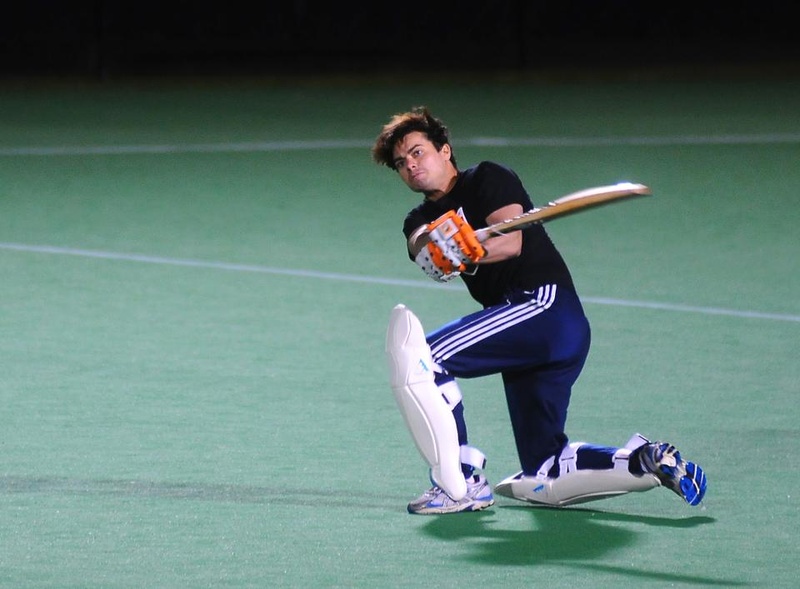Under the floodlights, Harvard and Yale stood shivering, squaring off against each other like so many teams before them in the schools’ storied past. Only, this wasn’t The Game. Not even close. The stands were empty, save for a handful of friends and family—a generous 15 spectators. And this was the first time the two teams had ever faced each other.
Harvard and Yale have competed for more than two centuries in dozens of sporting events, but never in cricket. Last Saturday the two teams met to play the first cricket Game in history.
The “Founded in 1868” splashed across the back of the Crimson jerseys is misleading; Harvard had a cricket team in the 1800s and competed against other northeastern and Ivy League schools.
The Crimson had extended an invitation to compete against Yale in 1887, but the Bulldogs didn’t have an official cricket team. But formal cricket hasn’t been seen at Harvard since 1927, and the club has remained dormant until only recently. Few people in the university could tell you the rules of cricket, and even fewer still probably know that Harvard now has a cricket club.
The administration only this year recognized the team as a club sport, and the team has only just started competing legitimately against other colleges. The game against Yale was the team’s fifth game—ever.
Despite the team’s infancy and anonymity, the few fans who stuck around until the end of the match witnessed a ferocious drubbing of the Bulldogs at the hands of the fledgling team. The final score-line read 249-72. Even those that know nothing about the sport can grasp that it was a blowout. Comparable to a 15-run rout in baseball, Harvard hit ball after ball over the fences and bowled out Yale in the 14th of 20 overs.
WHAT’S CRICKET, YOU SAY?
The average American could probably tell you very little about the sport of cricket, apart from its similarities to baseball. The parallels between the two are fairly obvious; there’s a batter and a pitcher, there are outs, and there are innings, albeit all with different names. The rules and lingo will sound strange to the uninitiated.
An ‘out’ is a wicket, an ‘inning’ is an over. It’s not called pitching, it’s bowling. Instead of rounding three bases, the batters run between two to rack up points. Hit out of the park and it’s six points, but if it bounces or rolls out of bounds, it’s only four.
A batter can’t get out if they miss a bowl, only if the wicket (three sticks) behind them are knocked over or they are run out; a batter could conceivably bat the entire inning, all twenty overs. In international cricket, innings last hours every day, and test matches last days on end. Match days are always big events, and cricket enthusiasts demonstrate their loyalties by spending entire days at the pitch.
For Americans, it might be hard to conceive of just how popular cricket is in some parts of the globe. In Pakistan, India, Australia, and other British-Empire-influenced areas around the world, the sport is unparalleled in popularity—especially true in South Asia where few other sports are followed. In last year’s Cricket World Cup, an estimated 123 million people tuned in to watch from India alone; that’s more than watched Super Bowl.
“I think it’s difficult to compare to a U.S. sport, because even for someone who’s not interested in sports, you will know when Pakistan is playing a game,” says junior captain Ibrahim Khan, the leader of the revival movement.
“In America, you have cities playing against each other so there’s no national pride. But most competitive cricket is played on an international level, and when your country is playing you will know because everyone will be talking about it.”
That said, cricket fanatics are working on popularizing the sport across the States. The club cricket team this year became the newest member of the newly founded American College Cricket conference. Although the conference was only founded in 2009, it now boasts more than 60 colleges across the United States and Canada, with more being added every year.
“Months of research confirmed for me the game was missing a tremendous opportunity for development by not pursuing an American modus operandi of development—that is, through college competition,” wrote ACC President and founder Lloyd Jodah in an email. “Colleges have provided the grassroots for development of major American sports unlike the rest of the world.”
Read more in Sports
Men's Water Polo Prepares for Ivy Championships













